2022-23’s Greatest Performances: Where Do They Rank in History? Sidney Crosby & Alex Ovechkin
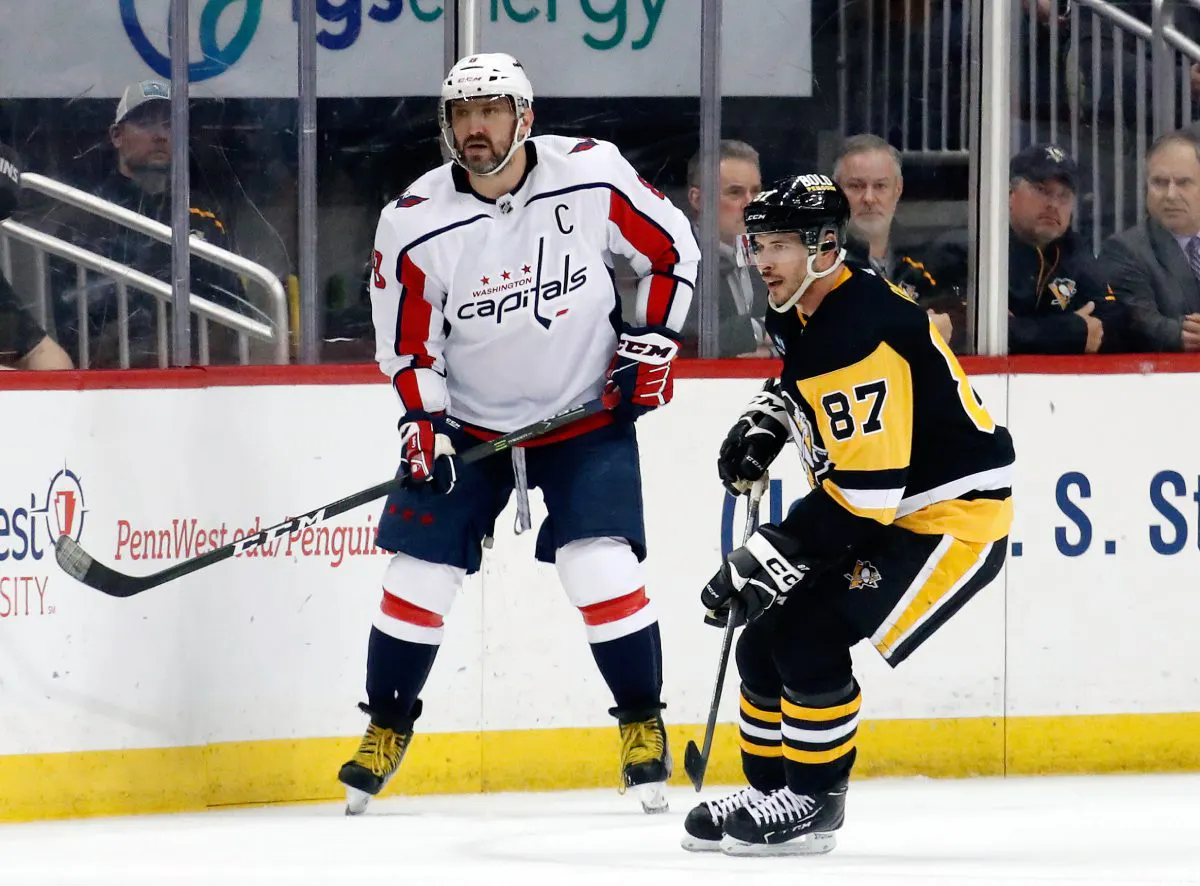
There’s a tendency to overhype the accomplishments of all-time great players long past their expiration date. We, as fans, simply don’t want to let go of the stars that long defined our love affair with a sport, a team, or a time and place.
Remarkably, when it comes to Sidney Crosby and Alex Ovechkin, we somehow haven’t had to let go yet. It’s been 18 years since the pair debuted to unprecedented dual fanfare – the eternal faces of the NHL’s post-lockout era. That season’s Rocket Richard winner, Jonathan Cheechoo, is 13 years removed from NHL action. The wins leader in 2005-06, Martin Brodeur, is nearly 51 years old. Yet, Crosby and Ovechkin endure.
While their 2022-23 performances for their ages are historically significant, it’s the relentless consistency of their play so deep into their careers that is most worthy of celebration.
Sidney Crosby
Almost as if Father Time has hit the snooze repeatedly, Crosby, at 35, is quietly still doing Crosby things. He was recently voted most complete player in the NHL by his peers. He became the first to ever score 30 goals at both age 18 and 35. He passed Gordie Howe by hitting a point-per-game 18 times, now trailing only Wayne Gretzky’s 19. He will soon become the 15th player to reach 1,500 career points. Quite the stretch.
That last feat has extra meaning given his career nearly ended at 23 at the peak of his powers. It’s easy to forget Crosby missed 101 games in two seasons from ongoing head and neck injuries. No longer “The Kid,” Sid continues to play the same grinding style. Like the beloved Roy Kent in the Ted Lasso series, “He’s here. He’s there. He’s every f#%$-ing where. Sid Crosby!”
In the spirit of this series, how rare is Crosby’s 2022-23 production for a 35-year-old?
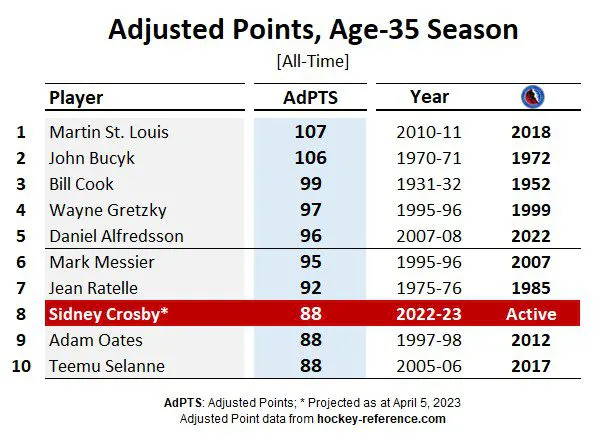
Quite rare, in fact. With a handful of games to go, he’s on pace to join the 10 most productive age-35 seasons in 100-plus years of NHL hockey. When we look beyond the numbers, the feat is much greater.
The Penguins are the NHL’s oldest team. They have no depth. Their once-vaunted power play is rudderless. Their goaltending is mediocre. For the first time in 17 seasons, a playoff spot has been a target, instead of a formality. With the longest post-season streak in North American team sports on the line, the pressure on Crosby to squeeze a few more miles out of this beat up Ferrari of a team is fierce.
Unlike for the ageless Martin St. Louis in 2010-11, there is no Steven Stamkos or Victor Hedman infusing youth and optimism to Pittsburgh’s roster. Unlike for John Bucyk, there is no Bobby Orr or Phil Esposito around to control the game. Unlike for Bill Cook, the season does not stop after 48 games. Unlike Wayne Gretzky, there is no mid-season trade destination ahead.
No, this season hasn’t been fun and games for Crosby, Evgeni Malkin and company. Far from it. If Crosby can lead this flawed team to the playoffs a 17th straight time, it will be yet another dazzling feather in that well-worn Penguins cap.
While Sid’s season may be special for a 35-year-old, it’s more of the same in the scope of his incredible career. The graphic below is an Adjusted Pace Card, a tool I’ve created to normalize season-by-season performance. Adjusted pace shows a player’s production each year in a neutral scoring climate over 82 games. Crosby’s is a sight to behold.
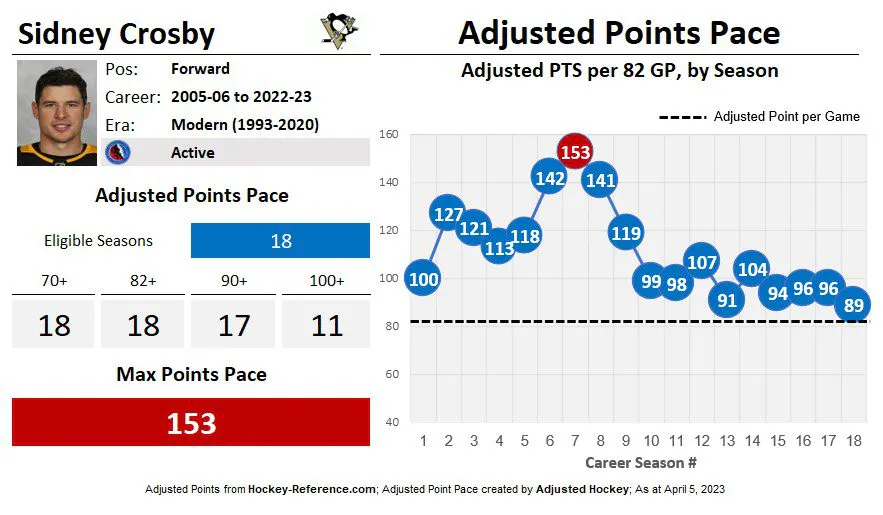
18 years into his career, the Penguins’ captain has never dipped below an 89 adjusted point pace. In terms of production, he’s remarkably been a similar player every year since his birthday cake hit 30 candles.
He’s done it all while being the focus of every pre-game discussion, in-game shift, post-game interview, and inch of air space. As a teenage prodigy expected to carry the NHL’s resurrection. As the youngest MVP in history. As a player in and out of the lineup when every hit could have been his last. As the engine of a Penguins team with Stanley Cup aspirations every year. As the face of Team Canada for two Olympic golds and a World Cup title.
No scandal. No disappointing whispers about his personal life. For 18 years, nothing has been certain but death, taxes, and Crosby’s brilliance.
Alex Ovechkin
A marketing dream come true, the hockey community has always lumped Sid and Ovie together. An often-overlooked nugget in their rivalry is that the pair are two years apart in age. This gave the 20-year-old Ovechkin the edge in their rookie seasons, an edge he would manifest into the Calder Trophy. In the present day, however, it’s the 37-year-old Ovechkin at a disadvantage. He’s two years ahead of Crosby on an aging curve that humbles every great athlete to put on a jersey.
Ovechkin is not every other great athlete.
No one will confuse the 2023 version with Ovechkin circa 2008. Today, Ovechkin is a defensive liability, among the sport’s least responsible by any measure. He hasn’t topped 40 assists in 12 years. The Capitals are badly weathered and will miss the playoffs for the first time since their captain was 28 years old.
Ovechkin continues to snipe.
His perpetual ability to score goals remains the most impressive skill in sports. That’s not a typo. 37-year-olds simply do not score many NHL goals. In 2022-23, only 13 skaters played a single game at this age or older. 37-year-olds are usually retired. If they are playing, they’re often injured, ineffective, or a flickering shadow of themselves.
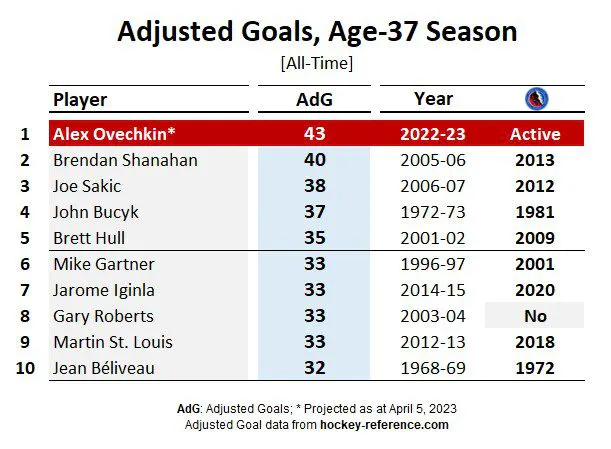
On a mission to break one of hockey’s most cherished records, he’s had the most productive era adjusted goal scoring season by a 37-year-old. Ever. Only 14 players his age have reached 30 adjusted goals. In a year where he lost his father, missed six games, watched the roster around him spontaneously combust, and dealt with some nagging injuries, Ovechkin is only the second player to hit 40 adjusted goals in his age-37 season.
Barring disaster, Gretzky’s record feels inevitable at this point.
Let’s check Ovechkin’s mesmerizing Adjusted Pace Card for goal scoring to echo the point.
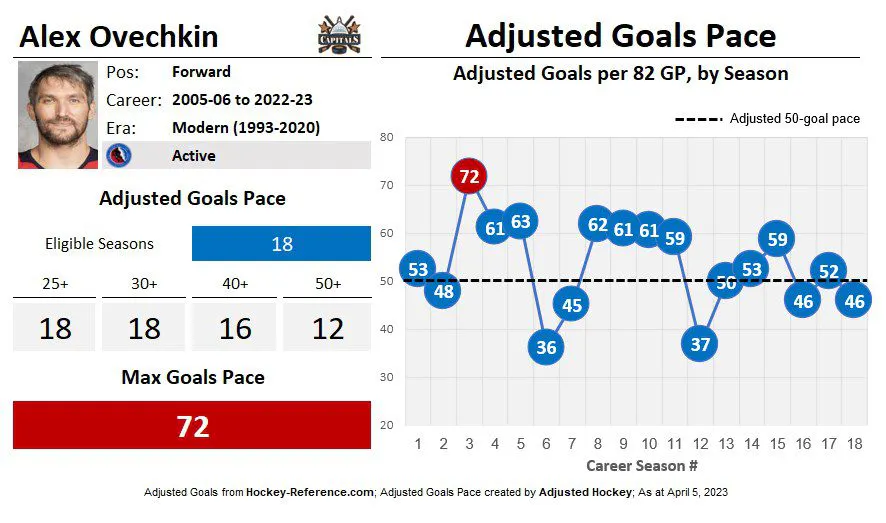
It’s incomprehensible to be this reliable, healthy, or productive for so long. In 18 bone-crushing seasons, Ovechkin has never finished outside the top 20 in goals. He has NINE Rocket Richard Trophies. He’s also played in a terrible time to be a goal scorer.
The Great Eight passing The Great One would add an exclamation point to an unparalleled goal scoring life of power play clappers, bar-down lasers, red lights, and glass leaps.
Closing Thoughts
If it seems like Crosby and Ovechkin have been great forever, it’s because they have been by hockey standards. Their 2022-23 feats only reinforce the sentiment.
On a boat. With a goat. In the rain. In the dark. On a train. In a car. In a tree. In a box. With a fox. In a house. With a mouse. Here and there. Anywhere.
Like green eggs and ham, Crosby and Ovechkin are great anywhere.
The two have been unyielding forces for nearly two decades. Sadly, their long-storied franchises are slowly crumbling. Their extended time in the sun will end soon, too. Human biology tells us that. But it hasn’t happened just yet. We’re all fortunate to get to watch the show, recently renewed for a mind-bending 19th season. Is there more history in store for their respective 36 and 38-year-old seasons next year?
Don’t bet against them.
Paul Pidutti is the creator of the Adjusted Hockey project, which brings context to hockey statistics. His Hockey Hall of Fame methodology, the Pidutti Point Share (PPS) system, is the first comprehensive measure of HHOF worthiness. You can find his work on Twitter (@AdjustedHockey) and adjustedhockey.com.
Adjusted GP & Pace stats from Adjusted Hockey; all other data from Hockey Reference
More from Paul Pidutti
- Father Time 2025: Are McDavid, Binnington and others on the decline?
- Surprise: great players rarely make great NHL coaches
- Overtime, loser points unleashing chaos in NHL’s Season of Parity
- Projecting the 2026 Hall of Fame Class: Bergeron, Price and endless possibilities
- Hall of Fame tiers: Which NHL stars are destined for immortality?